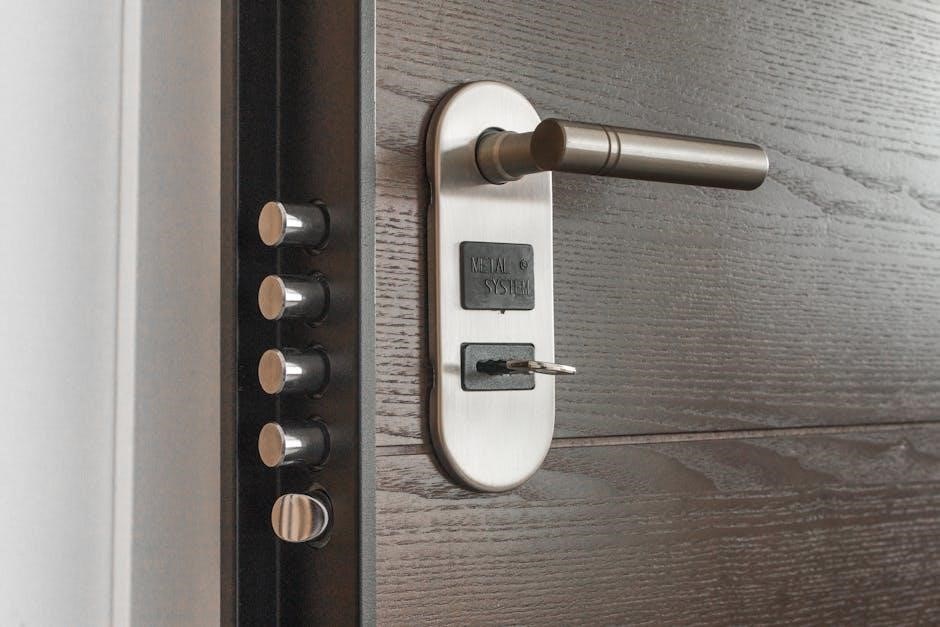
How to Manually Lock a Garage Door: A Comprehensive Guide
Manually locking your garage door ensures security when the automatic opener is disconnected. Pull the emergency release cord, engage the manual lock, and secure with a padlock for added safety.
Manual garage door locking provides an extra layer of security and reliability, especially during power outages. Engaging manual locks ensures your garage door remains secure and tamper-proof.
Why Manual Locking is Important
Manual locking is essential for enhancing garage security, especially during power outages or when the automatic opener malfunctions. It prevents unauthorized access and ensures your garage remains secure. Unlike automatic systems, manual locks provide a physical barrier that cannot be hacked or disrupted. This method is also cost-effective and reliable, offering peace of mind when you’re away from home. Additionally, manual locking can serve as a fail-safe when modern security systems fail, ensuring your belongings remain protected. It’s a simple yet effective way to add an extra layer of safety to your garage door.
When to Use Manual Locking
Manual locking is ideal during power outages, extended absences, or when the automatic opener is malfunctioning. Use it to secure your garage door when you’re on vacation or when the opener is being repaired. It’s also recommended if you notice suspicious activity in your area. For added security, manually lock the door at night or when leaving valuable items in the garage. This method ensures your garage remains secure even without relying on electricity or technology. Regular use of manual locking can also help prevent potential breaches and provide an additional layer of protection for your property.

Understanding Your Garage Door Mechanism
Your garage door mechanism includes an emergency release cord, manual locking features, and additional security devices like hasps. These components work together to ensure secure operation and control.
Emergency Release Cord: Location and Function
The emergency release cord is typically located near the top of the garage door, often marked by a red handle or cord. Its primary function is to disconnect the garage door from the automatic opener, allowing manual operation. When pulled down firmly, it disengages the door from the opener, switching it to manual mode. This feature is crucial during power outages or when manual locking is required. Always ensure the cord is accessible and functional, as it provides a quick way to control the door when needed. Regularly test the cord to ensure it operates smoothly and securely.

Manual Locking Mechanisms: Built-in Features
Most garage doors come equipped with built-in manual locking mechanisms for added security. These mechanisms are usually located in the center or along the sides of the door. A common feature is a sliding bolt that can be pushed outward to lock the door securely. Some doors also have an operating lever that, when moved, engages the lock. These mechanisms are designed to provide an extra layer of protection, especially when the automatic opener is disconnected. They are simple to use and require no additional tools. By engaging these built-in locks, you ensure the door remains closed and secure, even in manual mode.
Additional Security Devices: Hasps, Padlocks, and More

Beyond built-in mechanisms, additional devices can enhance garage door security. Hasps are metal brackets installed on the door and frame, allowing the use of padlocks for extra protection. Padlocks are simple, cost-effective solutions that provide an additional layer of security. For added reinforcement, C-clamps or vice grips can be attached to the door track to prevent movement. Spring-loaded locks are another option, offering quick and easy installation. These devices are particularly useful for older doors or in high-security situations. By combining these with built-in locks, you create a robust security system to safeguard your garage and its contents from unauthorized access.

Step-by-Step Guide to Manually Locking Your Garage Door
Manually locking your garage door involves disconnecting the automatic opener, pulling the emergency release cord, engaging the manual lock, and securing the door with additional devices like padlocks.
Step 1: Disconnect the Automatic Opener
To manually lock your garage door, start by disconnecting the automatic opener. Locate the emergency release cord, usually a red handle or cord, and pull it down firmly. This action disengages the door from the opener, switching it to manual mode. Ensure the door is fully closed before proceeding. If the opener is unplugged or powered off, this step may not be necessary; However, pulling the cord guarantees the door is no longer connected to the automatic system, allowing you to lock it manually. Always verify the door’s position to ensure it is closed properly before attempting to lock it.
Step 2: Engage the Manual Locking Mechanism
After disconnecting the automatic opener, locate the manual locking mechanism, typically found in the center or on the sides of the garage door. This mechanism may include a sliding bolt or a latch that you can engage to secure the door. To lock the door, push the sliding bolt outward or turn the latch until it clicks into place. Ensure the bolt or latch aligns properly with the door frame or track to hold the door securely. If your door has a keyhole near the top, you may need to use a key to engage the lock. Once locked, the door should not be able to be opened from the outside. Always verify that the lock is fully engaged for maximum security.
Step 3: Secure the Door with Additional Devices

For extra security, consider using additional devices to reinforce your garage door. Install a hasp where the door meets the ground and secure it with a sturdy padlock; This prevents the door from being lifted or forced open. Alternatively, use C-clamps or vice grips on the track above a roller to immobilize the door. These devices provide an extra layer of protection against unauthorized access. Ensure all additional locks are properly engaged and test the door’s security by attempting to open it. These measures offer peace of mind, especially when you’re away for extended periods or during power outages.
Step 4: Test the Lock for Proper Functioning
After securing your garage door, test the lock to ensure it’s functioning correctly. Gently pull on the door to confirm it doesn’t budge. Check the manual locking mechanism to ensure it’s fully engaged. If using additional devices like a hasp or padlock, verify they’re securely fastened. Attempt to lift or push the door to confirm it remains locked. Also, ensure the emergency release cord isn’t accidentally engaged, as this could override the lock. Testing the lock ensures your garage door is properly secured, providing peace of mind against unauthorized access or accidental opening.

Additional Security Measures
Enhance garage door security with hasps and padlocks for extra protection. Reinforce the door track for added safety, ensuring a robust barrier against unauthorized access or potential breaches.
Using Hasps and Padlocks for Extra Protection
Installing a hasp on the garage door where it meets the ground and securing it with a padlock provides an additional layer of security. This method is simple, cost-effective, and highly durable. Padlocks are easy to use and offer a visible deterrent to potential intruders. For maximum protection, choose a heavy-duty padlock with a sturdy chain or hasp. This setup prevents the door from being lifted or forced open, ensuring your garage remains secure even when the automatic opener is disengaged. Hasps and padlocks are especially useful for added peace of mind during extended periods away from home.
Reinforcing the Door Track for Added Safety
Reinforcing the garage door track enhances security and prevents unauthorized access. Use vise grips or C-clamps on the track above a roller to immobilize the door. Alternatively, install spring-loaded locks that attach directly to the track, ensuring the door cannot be opened. These methods are easy to implement and provide an additional layer of protection, especially during power outages or when extra security is needed. By securing the track, you prevent potential intruders from lifting or forcing the door open, offering peace of mind and added safety for your garage and belongings. This reinforcement is a practical and affordable security upgrade.
Manually locking your garage door is a straightforward process that enhances security and peace of mind. By disconnecting the automatic opener, engaging the manual lock, and using additional devices like hasps or padlocks, you ensure your garage remains secure. Regularly testing the lock and reinforcing the door track can further deter unauthorized access. These simple steps provide an effective way to protect your property, especially during power outages or extended absences. Follow these guidelines to keep your garage and belongings safe and secure. Thank you for reading this comprehensive guide on how to manually lock your garage door.